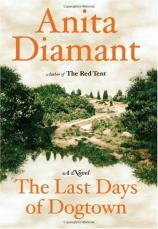The Last Days of Dogtown
Review
The Last Days of Dogtown
North of Boston, in the early 1800s, Cape Ann is a peninsula
jutting into the Atlantic and home to Dogtown Common. Between Sandy
Bay on the coast and Gloucester Town on Gloucester Harbor, Dogtown
is a dying village. Ironically, author Anita Diamant begins her
story with the death of Abraham Wharf by his own hand in 1814. The
villagers show respect and some grief for Wharf in the spacious
parlor of Easter Carter.
The party of mourners includes Judy Rhines, Easter's closest
friend, and twelve-year-old Oliver Younger, accompanied by his
peculiar Aunt Tammy, often called a witch and ill-humored as well.
Others in the company are Ruth, a black woman who dresses in
menswear; Mrs. Stanley and her son, Sammy; Mary, the grieving
sister of Wharf; and those who come out of the cold for liquid
hospitality.
Diamant paints a picture of rural nineteenth century with a gray
palette. An occasional bright passage illuminates her word canvas
with pale sunshine hues. For the most part, life is cruel in
Dogtown. From Boston to Gloucester, whispers of witchcraft, poverty
and idiocy abound when the little village is mentioned among
knowledgeable persons. Of course, none of the rumors are factual.
But legends become volumes when tongues wag about townspeople.
Roaming packs of dogs have made the village their home when the
fishing and farming industries dry up. Greyling, one of the more
fortunate strays, makes a home with Judy Rhines.
One by one, secrets kept for generations within the families of
Dogtown become truths known by others. Oliver has had a miserable
childhood with Aunt Tammy after his parents die. Tammy persecutes
him publicly and humiliates him daily. He is one of the bright rays
of sunshine crossing Dogtown. With the help of Judy, whom he
trusts, the paper that sets him free from Tammy is a secret no
longer kept. Each member of the tight community has darkness they
wish to remain hidden.
Diamant's earlier successful novel, THE RED TENT, was a tale of
reality for its characters --- structured lives in a remote
setting. THE LAST DAYS OF DOGTOWN, though far removed in place and
time, tells of a people oppressed by poverty, illness, ignorance
and racial inequality --- realities of their own. Reaction to this
book, though lukewarm at first, warmed with a passion to read to
its conclusion.
Judy Rhines, a spinster (though not of her choosing), is the center
of the novel. The others interact through and around her, as she
nurtures their physical and emotional upheavals with compassion and
sensitivity. When her needs are met by a shadowy character, she
rejoices only to be disappointed by rebuff. How she is sought after
for help and how she responds are threads that blend the gray
palette into a watercolor of lives given meaning. Though not a
quick read, this book based on a pamphlet from history is a
meaningful study of the early New England character and a good
literary piece.
THE LAST DAYS OF DOGTOWN is not triumph over tragedy, but an
opening of the human spirit to the possibility of loving.
Reviewed by Judy Gigstad on January 11, 2011
The Last Days of Dogtown
- Publication Date: August 30, 2005
- Genres: Fiction, Historical Fiction
- Hardcover: 288 pages
- Publisher: Scribner
- ISBN-10: 0743225732
- ISBN-13: 9780743225731





